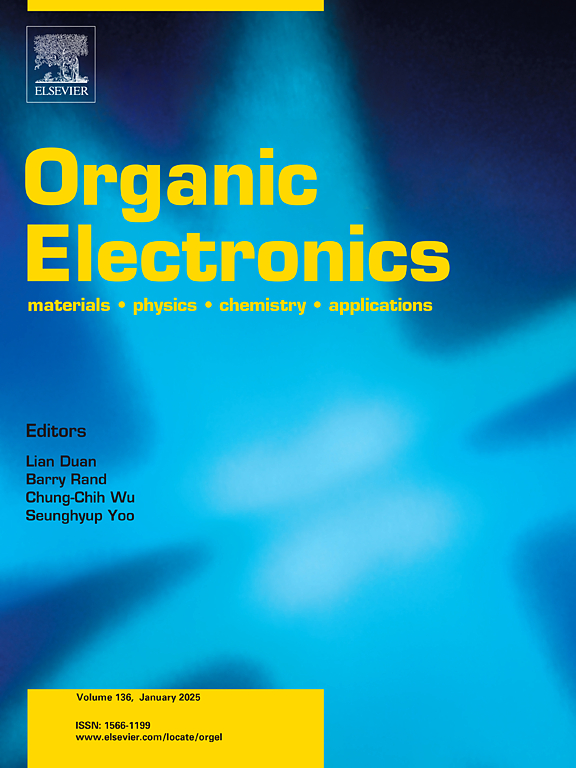Red thermally activated delayed fluorescence materials for high-performance organic light-emitting diode
IF 2.6
4区 工程技术
Q3 MATERIALS SCIENCE, MULTIDISCIPLINARY
引用次数: 0
Abstract
Developing red thermally activated delayed fluorescence (TADF) materials is challenging but crucial for realizing full-color displays and solid-state lighting systems. In this work, we propose a novel design strategy that connects two emitting units to a phenyl ring to create efficient red luminescent materials. Two D-A-π-A-D type TADF molecules with mild-twist structures, m-DTPAQCN and p-DTPAQCN, were designed and synthesized. These molecules incorporate an electron-withdrawing acceptor of quinoxaline-6,7-dicarbonitrile group and an electron-donating donor of triphenylamine group. Both m-DTPAQCN and p-DTPAQCN exhibit red emissions in toluene solutions at 607 nm and 614 nm, respectively, and in doped films at 618 nm and 627 nm. The doped films, prepared with varying doping concentrations, demonstrate excellent photoluminescence quantum yields (PLQYs) ranging from 60.10 % to 84.70 %. The corresponding organic light-emitting diodes (OLEDs) employing m-DTPAQCN and p-DTPAQCN as emitters present efficient red electroluminescence with a maximum external quantum efficiency of 17.37 % and 20.05 %, respectively. This work provides a new and effective strategy for designing efficient red TADF molecules, offering significant potential for application in OLEDs.

高性能有机发光二极管用红色热激活延迟荧光材料
开发红色热激活延迟荧光(TADF)材料具有挑战性,但对于实现全彩显示和固态照明系统至关重要。在这项工作中,我们提出了一种新的设计策略,将两个发射单元连接到苯基环上,以创建高效的红色发光材料。设计合成了两个D-A-π-A-D型轻扭结构的TADF分子m-DTPAQCN和p-DTPAQCN。这些分子包含喹啉-6,7-二腈基的吸电子受体和三苯胺基的供电子给体。m-DTPAQCN和p-DTPAQCN在甲苯溶液中分别表现出607 nm和614 nm的红光发射,在掺杂膜中表现出618 nm和627 nm的红光发射。不同掺杂浓度制备的掺杂薄膜具有优异的光致发光量子产率(PLQYs),范围为60.10%至84.70%。采用m-DTPAQCN和p-DTPAQCN作为发射体的有机发光二极管(oled)显示出高效的红色电致发光,最大外量子效率分别为17.37%和20.05%。这项工作为设计高效的红色TADF分子提供了一种新的有效策略,在oled中具有重要的应用潜力。
本文章由计算机程序翻译,如有差异,请以英文原文为准。
求助全文
约1分钟内获得全文
求助全文
来源期刊

Organic Electronics
工程技术-材料科学:综合
CiteScore
6.60
自引率
6.20%
发文量
238
审稿时长
44 days
期刊介绍:
Organic Electronics is a journal whose primary interdisciplinary focus is on materials and phenomena related to organic devices such as light emitting diodes, thin film transistors, photovoltaic cells, sensors, memories, etc.
Papers suitable for publication in this journal cover such topics as photoconductive and electronic properties of organic materials, thin film structures and characterization in the context of organic devices, charge and exciton transport, organic electronic and optoelectronic devices.
 求助内容:
求助内容: 应助结果提醒方式:
应助结果提醒方式:


